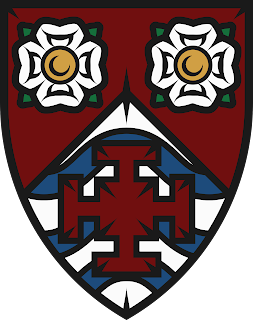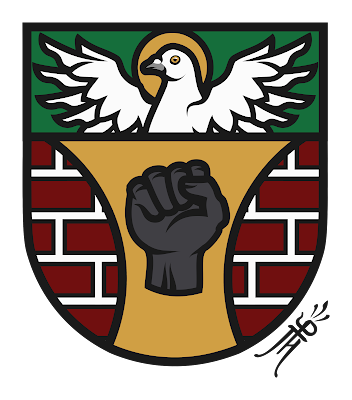 |
| The arms of Chad Krouse, assumed in 2014, and rendered by Dimitri Prica, August 18, 2023. |
I recently commissioned a digital heraldic artist through Discord's Heraldry Server to emblazon several shields so that I could update my blog's masthead. Click here to read more about this community of heraldic enthusiasts. As this blog has evolved since its earlier days of random thoughts to now focusing on heraldic research, I thought it was time to get a proper masthead to reflect where I am in life--we're still refining it. The digital artist, Dimiri Prica, did an amazing job with these coats, a link to his portfolio can be found to the reader's left under "websites of interest." Prica is a young digital heraldic artist in France. I first commissioned Prica during the summer of 2020 to render the attributed arms I designed for the Black Lives Matter movement--my one and only viral moment in history. Click here to read more about the attributed arms of the Black Lives Matter movement. Following that design, Aemdal rendered both an ex libris and my heraldic badge. I appreciate and enjoy the artist's style, which feels fresh and young.
 |
| The attributed arms of the Black Lives Matter movement, designed by Chad Krouse on June 10, 2020 and rendered by Dimitri Prica. |
The artist's style is unique, employing darker colors with various shading techniques to accent certain elements. The rendering of my arms as seen above exemplifies the artist's careful eye. Prica's style, in my opinion, gives a respectably modern feel. While the blazon remains static for all coats of arms, the heraldic artist does enjoy certain freedoms, such as how to actually draw the charges, etc.
My research muse Pierre de Chaignon La Rose (1872-1941) would likely have a strong opinion on the use of darker colors in heraldry. La Rose was interviewed in 1933 regarding the newly adopted arms for the University of Pennsylvania, where he adds:
"Gules in heraldry is bright red--heraldry knows nothing about crimson, cherry, etc. which is purely a livery detail. In one's liveries (and athletic colours and academic hoods come under that head) one may establish any shade or tone of colour one chooses, but not so in heraldry...One may fixe a 'blazon' for all time...(in this case the principal symbols of the Penn and Franklin Arms)...but every subsequent painter, carver, or die-cutter is wholly at liberty to carry out the blazon in his own manner...
In other words, the actual draughtsmanship of heraldry is a very flexible thing, and an heraldic composition is good or bad according the disposition and colouring of its charges, not their draughtsmanship" (The Pennsylvania Gazette, 1933, 2-4).
As someone once said, there is no accounting for taste. And who knows, perhaps la Rose would have embraced the digital age.
.PNG) |
| Ex libris for Chad Krouse and rendered by Dimitri Prica, June 4, 2020. |
I am absolutely giddy for now having full color digital emblazonments of all the arms of my two alma maters that bear arms--Sewanee: The University of the South and Hampden-Sydney College. One day I plan to devise arms for my third.
Previously, there were no digital renderings in the public domain for any of Sewanee's heraldry. So to have these digital emblazonments today makes me happy, as they are lovely arms. To that end, I've updated my post on the heraldry of Sewanee: The University of the South. Click here to read more about the Heraldry of Sewanee. That this previous post has been viewed more than 1,400 times since writing it in 2014 illustrates the interest in Sewanee's heraldry.
Some unique design elements rendered by Aemdal for Sewanee's heraldry include the shading points within the university's pall cross. I also love how the crossed fleam in the School of Theology's coat is rendered. Finally, Prica simply did full justice to McCrady's "Sewanee Tressure," as I have seen versions where this gets butchered--the counter-changed crosses tend to be larger in size when compared to the other crosses within the tressure.
I'm also adopting several "style standards" in order to be consistent with posts:
- I will continue using APA 7th Edition for all citations and references. While I learned MLA during undergraduate studies followed by The Chicago Manual of Style with my master's work (still miss this style), I was sufficiently indoctrinated with APA for my doctoral research. It's easier and faster
- Blazons will be in bold. When Latin is used within a blazon, I will capitalize all letters and provide a translation in parenthesis
- The first time a person's name is mentioned, I will use bold to off-set it. If the person is no longer alive, I will add their dates in parenthesis.
- Whenever I add a reference to a previous blog post, I will clearly define the link by writing, "Click here to read..." so as to avoid any confusion that the link is spam or sending the reader into the ether
- I will endeavor to cite anything that is not either my own work or work that is well-known to the general public. As a scholar-researcher, it is critical to show where I find things. This principle lends more credibility to any work
- I've gone through and revised all "tags" for my posts in order to give the reader an easier tool to search posts based on a given topic--Scholastic Heraldry, Ecclesiastical Heraldry, etc.
I've also added my personal email address to my profile so that readers who wish to correspond may do so. Sometimes, simply throwing my research out into the void feels rather lonely. Thus, I strongly encourage readers to comment on anything! Feedback is critical to growth, and I do appreciate feedback--good or bad.
Works Cited
Anonymous. (1933). The coat-of-arms and flag. The Pennsylvania Gazette, vol 32(1), 2-4.







0 comments:
Post a Comment